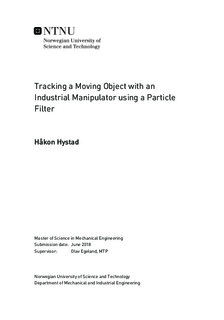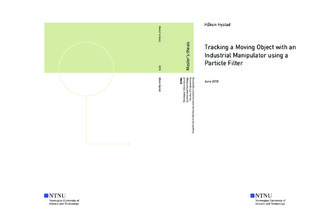| dc.description.abstract | As industries are getting more automated the demand for new sensor technologies and algorithms increases. Industrial manipulators have for instance been equipped with more sensors to handle increasingly complex tasks to further automate manufacturing. Particularly there is now a desire to handle objects with undetermined movements in real-time.
This thesis will present a way to estimate the position, orientation and velocities of a suspended object. This is accomplished by using a particle filter on image data to get the most likely estimates.
Some issues such as open-loop control and the sheer amount of particles needed for the filter have been tried mitigated through optimization. As the system is heavily dependent on camera calibration a new calibration routine and optimization was proposed and the particle filter was efficiently implemented on a graphical processing unit.
The proposed calibration optimization have been substantiated, through real-world experiments, to be less accurate than a usual form of calibration even though simulations proved it better. Luckily the traditional calibration was seen to have satisfactory accuracy. The filter have no problems running with 500 000 particles between frame captures at 33fps, which points to an efficient implementation.
To test the validity of the approach a case study was planned where the particle filter estimates was to be fed on-line to an industrial manipulator to follow a moving object with a fixed pose relative to the object itself. Tests showed that as long as the object is unique enough in the images it can be tracked with decent accuracy by the particle filter, they also showed that an industrial manipulator could be controlled smoothly by simulated filter output. The complete experiment was on the other hand never conducted due to time limitations and safety concerns.
Since the local coordinate system has been shown to be known and followed it is plausible that work could be done on the swinging and otherwise moving object as if it was at rest. With further improvements applications for this range from picking suspended parts of conveyors to complex tasks performed on the object while it is suspended on an assembly line. | |

